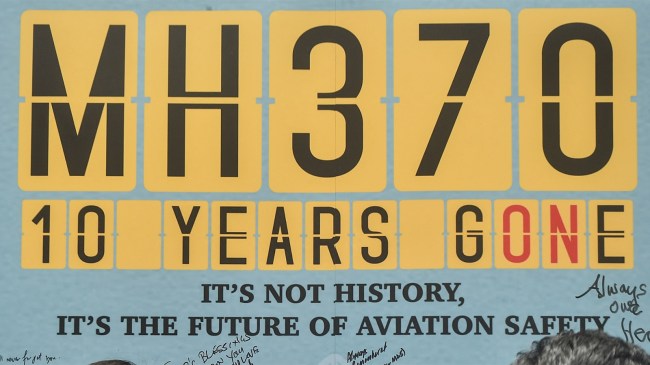Getty Image
In the over 10 years that Malaysia Airlines Flight MH370 mysteriously disappeared out of the sky without a trace, there have been a wide assortment of theories about what happened to the 239 people who were on the plane when it vanished.
One of the more popular theories is that the pilot deliberately shut off the plane’s datalink system and crashed it into the ocean.
Another is that Flight MH370 was hijacked.
Some, including British tech expert Ian Wilson, have claimed that they have spotted the plane on Google Maps in a jungle in Cambodia.
Several times over the past 10 years people have also claimed to have discovered remnants of the missing airliner.
For example, an Australian fisherman claimed that he accidentally reeled in what he believed was a wing of a commercial airliner in the same location area that has long been speculated to be where Flight MH370 crashed.
Others have claimed that they have been able to pinpoint the location of the missing Flight MH370 plane.
And yet, Malaysia Airlines Flight MH370 and the 239 people who were on board have still not been found.
Now, Richard Godfrey, a retired British aerospace engineer and owner of the website The Search for MH370, believes that it will take just one more search to finally locate Flight MH370 and explained his findings to the BBC.
Godfrey’s effort has included studying what’s known as WSPR signals of radio amateurs from the night of the plane’s disappearance. Radio amateurs are constantly sending test signals and recording that signal data, something that’s been taking place for decades. And here’s why that data matters so much, he says: because when a plane flies through a radio signal, it disturbs the signal and from that disruption you can track the presence of an aircraft.
“So I went back to March 8, 2014 and downloaded all of the signals” Godfrey said. There are thousands of them, and I started from the last known point of MH370, defined by the radar, and tracked its path,” explains Godfrey. “The results from my tracking align exactly with the satellite data for MH370, and the Boeing data, and the oceanography data.”
After studying and analyzing the data, Godfrey came to a conclusion.
“The MH370 crash location, defined by the WSPR technology, is within a circle with a radius of 30 kilometers and centered at 29.128°S 99.934°E,” he said. “This area is 1,560 kilometers west of Perth, Australia. It will only take one more search of this area and we will find MH370.”
Another amateur investigator, Vincent Lyne, a former researcher from the Institute for Marine and Antarctic Studies (IMAS) at the University of Tasmania, also believes he has figured out where the missing plane is located.
“The precise location of MH370 is in a very deep 6000-metre hole about 1500 kilometers west of Perth and along the longitude of Penang,” Lyne told the BBC. “That location reconciles all evidence.”
Lyne claims that the pilot “left a long-lasting trail of highly visible anomalies in five independent satellite images from three satellite passes.”
Should the missing plane end up being found in water that deep it would be ideal for preserving evidence, said Godfrey.

